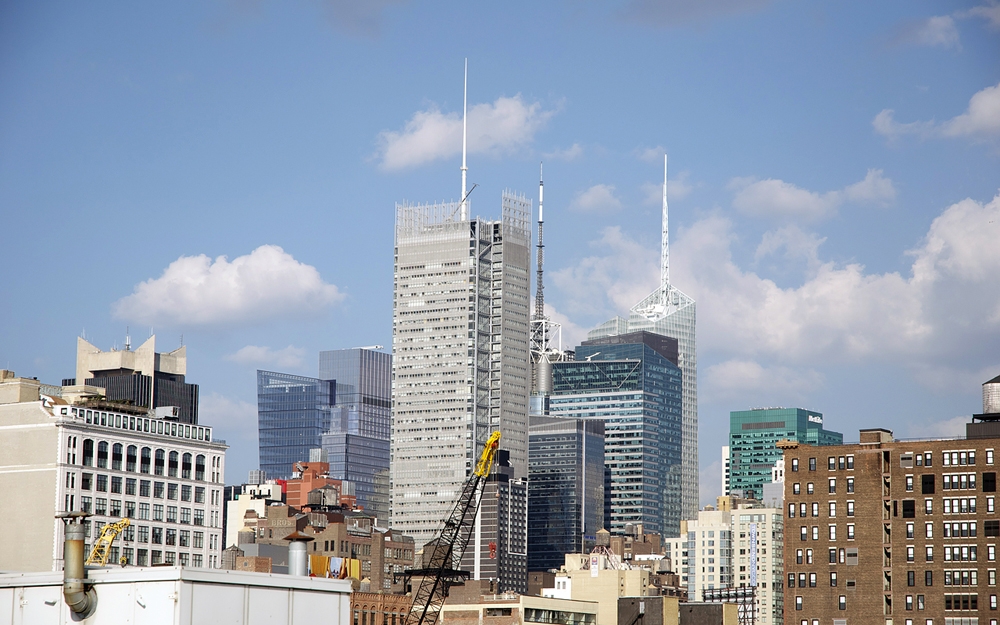The What’s That Building? feature covers new and old architecture along the High Line corridor, and that it originally included snapshots of towers and spires that we can see in the distance. I’ve moved those “glimpses of architecture” to this page because construction on both sides of the park has added so many buildings that everything didn’t comfortably fit on one page. If you have the chance to walk the High Line at night you can see the beautiful light show that the three buildings above put on, as their LED-covered spires slowly change colors. They are part of the new Manhattan skyline, and the High Line is a great place to experience it.
Goldman Sachs Tower, Jersey City, New Jersey
The skyscraper that rises above the Hudson River at the foot of New York Harbor is Goldman Sachs Tower. Designed by Cesar Pelli and completed in 2004, it’s the centerpiece of a recent wave of new development that started in Jersey City in the 1980s. The building occupies the site of a former Colgate factory and is perhaps most famous (in New York, at least) for the fact that masses of Goldman Sachs executives refused to step off Manhattan island to go work there. I wouldn’t want to work there either (for too many reasons to name), but it’s a fun building to photograph because light dances off its glass facade and, like a giant mirror, it reflects other buildings nearby. Architectural Height: 781 feet.
Met Life Tower, 1 Madison Avenue
The tower and cupula of the Metropolitan Life Insurance Company Tower can be seen from various spots along the High Line, and is particularly beautiful at night, when the golden dome shines against a dark sky. The building is located on Madison Avenue at 24th Street and was designed by Pierre LeBrun of Napoleon LeBrun & Sons. It was completed in 1909 and has an architectural height of 700 feet.
The NY Life Insurance Building, 51 Madison Avenue
The High Line offers tantalizing glimpses of the golden triangular tower — consisting of 25,000 gold-leaf tiles — of the New York Life Insurance Company Building, but it’s hard to get a full view. The building is located on Madison Avenue between 26th – 27th Streets on a site once occupied by the Union Depot, a terminal of the New York and Harlem Railroad. Designed by Cass Gilbert (architect of the R.C. Williams warehouse above), it was completed in 1928 and has an architectural height of 615 feet — almost one hundred feet lower than its neighbor the Metropolitan Life Building, with its tall clock tower and gilded cupula.
Bank of America Tower, One Bryant Park
The Bank of America Tower is one of my favorite new buildings in Manhattan. At night, the 255-foot ornamental spire — which consists of 368 LED floodlights — changes color every few seconds, creating a light show with its neighbor the Conde Nast Building that’s so beautiful and uplifting it can melt the heart of even the most jaded New Yorker. Designed by Cook + Fox Architects, the building was completed in 2009 and was decreed the greenest building in Manhattan by the New York Academy of Sciences. The slideshow shows some additional views of this marvelous building.
The Condé Nast Building, 4 Times Square
Completed in 1999, the Condé Nast Building in Times Square is considered one of New York’s greenest buildings and was recognized by the American Institute of Architects for its use of solar and fuel-cell technology. Its 300-foot mast is used to support television and radio broadcasters, and at night it joins the Bank of America Tower spire in a theatrical display of light and color. The architect was FXFOWLE.
The New York Times Building, 242 W. 41st Street
The New York Times headquarters was designed by Renzo Piano and completed in 2007. The building’s facade, a curtain of ceramic rods that rises from street level to roof, reduces energy costs by helping block sunlight. The exterior cladding also encourages climbers: at least three men have been arrested trying to summit the building. The 1,000 foot mast on the roof contains radiometers that gather and transmit solar data to a computer system that in turn controls the position of the window shades throughout the building.
Monastery and Church of St. Michael and the Archangel, Union City, New Jersey
Across the Hudson River and visible from many spots along the High Line is the Roman Catholic Monastery and Church of St. Michael the Archangel. It’s located in Union City, New Jersey, and was “solemnly dedicated” in 1864, according to the Times, which also commented that “The tender influences of religious meditation could scarcely have a more agreeable retreat for exercise.” The architect was Patrick C. Keely.
Hearst Magazine Tower, 959 Eighth Avenue
One of my favorite new buildings in New York is the Hearst Magazine Tower. I watched it go up with great fascination when I worked at Random House, just a block or two away, and now get great joy from the glimpse of the tower at the end of the High Line at 30th Street. The architects, Foster + Partners, managed to place a whimsical modern structure atop a 70-year old landmark and succeeded in creating one building that successfully, even gleefully, embraces old and new styles. It’s New York City’s first LEED Gold skyscraper, and has an absolutely wonderful atrium with a 3-story waterfall and tons of natural light.
One Worldwide Plaza, 350 W. 50th Street
One Worldwide Plaza is an office tower on 8th Avenue between 49th & 50th Streets. It was designed by David Childs of Skidmore Owings & Merrill and completed in 1989. The distinctive triangular roof is made of copper and glass and can be quite striking at dusk and in the early evening when the pyramid at the very top begins to glow.












